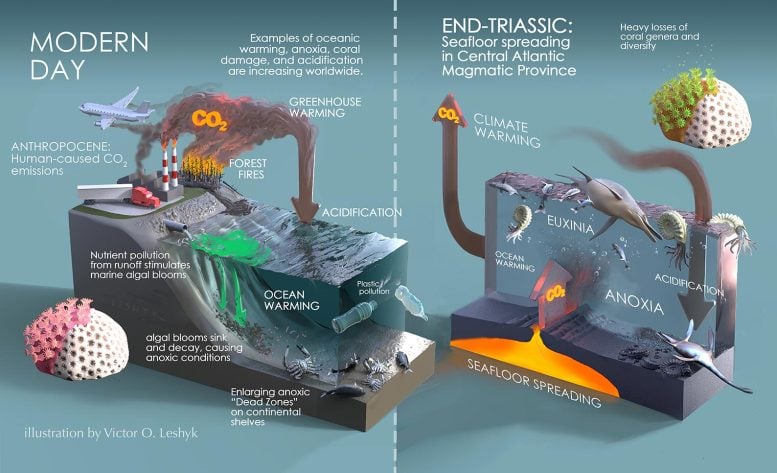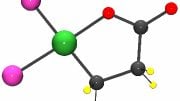
research revealed the twin processes that combined to the end the Triassic era, paving the way for the emergence of dinosaurs in the Jurassic period.
N ew research has revealed an increase in levels of both acid and hydrogen sulfide in the ocean was the double whammy that wiped out marine life during a mass extinction event 201 million years ago.
Lead author, Curtin University PhD graduate Dr. Calum Peter Fox, from the WA-Organic and Isotope Geochemistry Centre (WA-OIGC) in Curtin’s School of Earth and Planetary Sciences, said the research revealed the twin processes that combined to the end the Triassic era, paving the way for the emergence of dinosaurs in the Jurassic period.
“The end-Triassic event saw rapid increases in CO2 due to a surge in volcanic activity, which is understood to have caused unfavorable conditions for life resulting in mass extinction, however, the multiple drivers for loss of life during this period were not previously known,” Dr. Fox said.
“By studying microscopic fossils preserved in rock in the Bristol Channel Basin, in the southwestern United Kingdom, we identified the twin mechanisms responsible for the mass extinction.
“These were a deadly combination of ocean acidification, which inhibited growth of all marine life using calcium carbonate to create shells or body parts such as mussels, oysters, and corals, and rising levels of hydrogen sulfide in the ocean, which was extremely toxic for all marine life.”
Co-author John Curtin Distinguished Professor Kliti Grice, also from WA-OIGC in Curtin’s School of Earth and Planetary Sciences, said the research provided intricate and important details of the history of our ever-evolving planet.
“The revelations about the cause of past marine extinctions will help us understand the current global warming crisis and how we can protect our deteriorating ecosystems and environment,” Professor Grice said.
“In order to help understand how our environment and ecosystems may change during this event, we must investigate those in the past.
“There is still much to learn about mass extinction events and studying these disruptive time intervals further will inform us more about the history of our Earth, but also what climatic changes we can expect moving forward as CO2 levels continue to increase.”
Reference: “Two-pronged kill mechanism at the end-Triassic mass extinction” by Calum P. Fox, Jessica H. Whiteside, Paul E. Olsen, Xingqian Cui, Roger E. Summons, Erdem Idiz and Kliti Grice, 5 January 2022, Geology.
DOI: 10.1130/G49560.1
This research, led by Curtin University and funded by the ARC, was conducted in collaboration with researchers at the University of Southampton, Lahmont-Doherty Earth Observatory, MIT, and Oxford University. Dr. Fox did the research as part of his PhD studies at Curtin and is now at Khalifa University.









Conflating the Triassic mass extinction with AGW? The important thing, obviously, is to work in the climate catastrophe angle for funding purposes. But quantification would be nice.
What was the CO2 level that caused catastrophic ocean acidification? It’s doubtful the planet is anywhere near that level now given that, science tells us, CO2 levels in the past were many multiples higher than now: Present-day ppm of about 400 is very low; evolution optimized modern plants for 1500-2000 ppm.
I think it is quite valid to draw comparisons with past extinction events. Even if present CO2-concentrations are not (yet) comparable to those at the end of the Triassic period, the observed (most likely anthropogenic) CO2-increase coupled with ocean warming can trigger positive feedback loop that may result in a runaway effect which is impossible to reverse once it has gathered some momentum. It’s therefore imperative to think ahead, as a mere reacting to climate change / air&ocean-pollution effects is bound to cause an actual climate catastrophe in the short or long run.
I read a science site that fossilized tree leaves had fewer stomata. Then current trees do. That showed that CO2 was much higher. The world is 20° greener now
Kevin, the Triassic event was 201 million years ago. Modern flowering plants, angiosperms, first appeared in the fossil record about 134 million years ago. One of the features they tend to have is smaller cells, which means more stomata per surface area, which allows them to pull in more CO2.
https://www.plantsnap.com/plant-encyclopedia/angiosperms/
Conifers are the majority of non-angiosperm plants.
Also, a number of angiosperms, mostly grasses, have developed C4 and CAM photosynthesis for better utilization of CO2 in dry areas.
https://en.m.wikipedia.org/wiki/List_of_C4_plants
“that combined to the end the Triassic era”
I love the article and the info it’s talking about but now days I can’t tell if people take their work very serious because they just want the quick clicks 🙁 Gotta do some more editing and proof reading my dude!
I’m curious about how gradually the CO2 built up to that point and how long it took. Also, other variables that might’ve sped up or slowed down the process. And realistically possible measures that can be taken to keep earth a stable planet. The problem is, I don’t know if planets are meant to stay the same because THEY’RE PLANETS! Even if we control the climate for another 100,000 years, how long until an exploding star or an asteroid hits us like the snap of a finger. I suspect if I’m okay after driving home, I’m lucky to be alive because I’m a lot more likely to die from that. Ultimately, my point is… Learn history and be grateful for the time you’ve had and the time you still have right now because sh*t be crazy out there people! I’m talking about geological timelines that reveal to us that we do not control nature, we are just part of its ever-changing and immeasurably powerful forces. But please, can we really focus on cleaning up the ocean?! I mean, if 10% of the people on earth focused on sh*t like that, we would be way better off than we are. I know enough to know I don’t know sh*t, but I know that’s the truth brother
(said in Hulk Hogan voice) Now put that in your article comment section and smoke it!
Funded by the Click Bait Patrol Foundation TM
(I apologize for the language and bad English but this is my original comment)
Another classic example of how industry and automobiles during the Triassic Period caused Global Warming and mass extinction. If only they had a carbon tax to save them… 🤔
What’s the point in accelerating climate catastrophe with all the carbon emissions instead of working towards reversing it?
Pure garbage.
“a positive feedback loop that may result in a runaway effect which is impossible to reverse” (Patrick Miller)
That’s the scary scenario AGW doom-mongers wave around, but seriously, the geological record shows the climate varies wildly and naturally (stability is a myth: an ice sheet a mile thick covered North America very recently; during the last Pleistecene interglacial it was warmer than today). Within those great variations, no catastrophes without an exogenous cause.